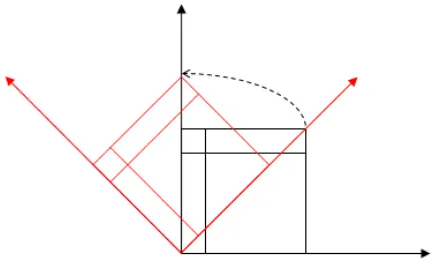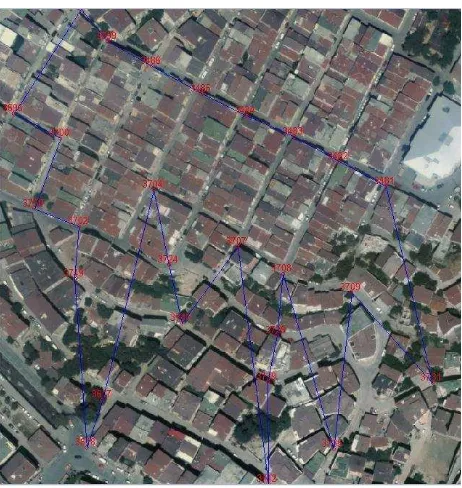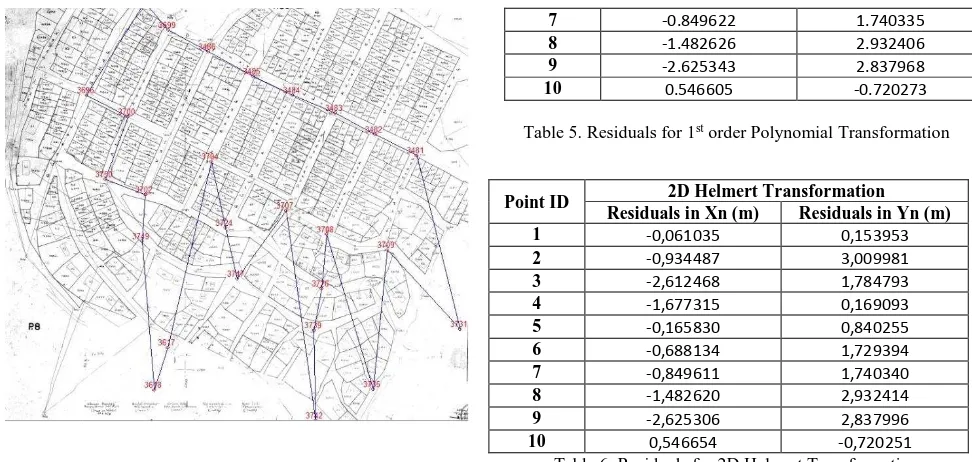TRANSFORMATION METHODS FOR USING COMBINATION OF REMOTELY
SENSED DATA AND CADASTRAL MAPS
Ş. Ö. Dönmez a, A. Tunc a, *
a ITU, Civil Engineering Faculty, 80626 Maslak Istanbul, Turkey - (donmezsaz, tuncali1)@itu.edu.tr
KEY WORDS: transformation methods, aerial orthophotos, cadastral maps
ABSTRACT:
In order to examine using cadastral maps as base maps for aerial orthophotos, two different 2D transformation methods were applied between various coordinate systems. Study area was chosen from Kagithane district in Istanbul. The used data is an orthophoto (30 cm spatial resolution), and cadastral map (1:1000) taken from land office, containing the same region. Transformation methods are chosen as; 1st Order Polynomial Transformation and Helmert 2D Transformation within this study. The test points, used to determine the coefficients between the datums, were 26 common traverse points and the check points, used to compare the transformed coordinates to reliable true coordinates, were 10 common block corners. The transformation methods were applied using Matlab software. After applying the methods, residuals were calculated and compared between each transformation method in order to use cadastral maps as reliable vector data.
1. INTRODUCTION
Modern mathematics characterizes transformations in terms of the geometric properties that are preserved when the transformations are applied to features. For mapping, analysis, and georeferencing purposes we usually value one particular set of properties over all others: area when computing areas, orientation when computing directions, distance when computing distances, (local) angles when computing angles, similarity when comparing shapes, incidence and inside versus outside when performing topological comparisons, and so on. In each case there is a group of invertible transformations of the plane that preserves the desired properties. As surveyors we practise our engineering analyses in alternative coordinate systems. So in most cases, like every map and GIS user, we use 2D and 3D coordinate transformations. In this research 2D coordinate transformation procedures for 1st degree Polynomial Transformation and Helmert Transformation are implemented to compare cadastral map coordinates of the 10 check points of two block corners.
A polynomial transformation is a non-linear transformation and relates 2D Cartesian coordinate systems through a translation, a rotation and a variable scale change. The transformation function can have infinite number of terms (Knippers, 2009).
Calculation of transformation parameters between aerial orthophoto and cadastral map coordinates using first order polynomial transformation can represent in mathematically as follows.
Xn = a1Xo + a2Yo +a3 Yn = a4 Xo+ a5Yo +a6
Xo – X coordinates of aerial orthophoto Yo – Y coordinates of aerial orthophoto Xn – X coordinates of cadastral map
Xn – X coordinates of cadastral map
a1, a2, a3, a4, a5 and a6 are unknown parameters.
2D Helmert transformation is a special case that is only needed 4 parameters (two translations, one scaling, one rotation). It is needed at least two known points (X, Y), İf there is more than two known points, it is needed to apply adjustment operations, and check points can be used for accuracy calculations. The other name of this transformation method is similarity transformation. In this transformation, figures preserve own shapes which means angles between lines does not change. The edges of the smooth geometric shapes grow or shrink at the same rate.
First system coordinates (given): xo, yo; Second system (transformed) coordinates: xn, yn; k01, k02: displacement parameters
ϕ: rotation angle; angle between x’and x; y’ and y. λ: scale;
xoλxo, yoλyo
A sample of graphic representation of the systems is shown in Figure 1 below.
Figure 1. Graphic representation of 2D Helmert transformation
General formula is shown:
The International Archives of the Photogrammetry, Remote Sensing and Spatial Information Sciences, Volume XLI-B4, 2016 XXIII ISPRS Congress, 12–19 July 2016, Prague, Czech Republic
This contribution has been peer-reviewed.
xn=k01+ λ xo cos ϕ- λ yo sin ϕ yn=k02+ λ xo sin ϕ- λ yo cos ϕ
k01, k02, λ,ϕ are translation parameters. These equations; with translation of k11= λ cosϕ k11=λ sinϕ;
xi’= k01 + xi k11 – yi k12
yi’=k02 + yi k11 + xi k12; and scale factor(λ), ϕ are calculated as; λ = √ � + �
ϕ=arctan �� (Demirel, H.)
2. DATA SET
The used data is an orthophoto (30 cm spatial resolution), and cadastral map (1:1000) taken from land office, containing the same region.
The test points, used to determine the coefficients between the datums, were 26 common traverse points; the check points, used to compare the transformed coordinates to reliable true coordinates, were 10 common block corners.
Point I.D.
Aerial Orthophoto Traverse Point Coordinates (ITRF96)
Xo (m) Yo (m)
3481 4549961.084 415150.253
3482 4549976.166 415121.215
3483 4549991.675 415093.301
3484 4550004.615 415063.577
3485 4550018.322 415035.793
3486 4550035.790 415004.512
3617 4549828.135 414973.700
3618 4549798.466 414963.811
3696 4550006.120 414918.530
3698 4550070.894 414960.235
3699 4550051.187 414976.807
3700 4549990.610 414947.434
3702 4549935.854 414959.106
3704 4549958.513 415005.709
3707 4549923.337 415057.907
3708 4549906.493 415086.225
3709 4549894.942 415128.947
3724 4549912.044 415015.247
3726 4549868.332 415082.328
3731 4549838.663 415179.418
3735 4549797.395 415117.895
3739 4549839.144 415076.666
3742 4549775.768 415077.065
3747 4549875.937 415023.037
3749 4549903.251 414956.335
3750 4549947.093 414931.083
Table 1. Aerial orthophoto traverse point coordinates (ITRF96)
Figure 2. Aerial orthophoto test point representation
Point I.D.
Cadastral Map Traverse Point Coordinates (ED-50)
Xn (m) Yn (m)
3481 11051.470 -6637.240
3482 11066.210 -6666.450
3483 11081.390 -6694.540
3484 11093.980 -6724.410
3485 11107.360 -6752.350
3486 11124.460 -6783.830
3617 10916.480 -6812.210
3618 10886.700 -6821.750
3696 11093.790 -6869.450
3698 11159.040 -6828.510
3699 11139.530 -6811.710
3700 11078.620 -6840.370
3702 11024.010 -6828.060
3704 11047.210 -6781.730
3707 11012.650 -6729.130
3708 10996.140 -6700.620
3709 10985.090 -6657.770
3724 11000.860 -6771.650
3726 10957.940 -6704.070
3731 10929.410 -6606.650
3735 10887.430 -6667.680
3739 10928.690 -6709.390
3742 10865.330 -6708.250
3747 10964.850 -6763.440
3749 10991.380 -6830.450
3750 11034.920 -6856.210
Table 2. Cadastral map traverse point coordinates (ED50)
The International Archives of the Photogrammetry, Remote Sensing and Spatial Information Sciences, Volume XLI-B4, 2016 XXIII ISPRS Congress, 12–19 July 2016, Prague, Czech Republic
This contribution has been peer-reviewed.
Figure 3. Cadastral map test point representation 3. APPLICATION
After applying the 1st order Polynomial transformation and 2D Helmert transformation methods, the transformation coefficients calculated using Matlab software.
Parameter Approximated Value (1st order Polynomial)
a1 0.999830533153803
Parameter Approximated Value (2D Helmert)
k01 -4542989,16636722
k02 -368541,351771835
k11 0,999830254761944
k12 -0,0116870608244562
Table 4. Calculated transformation coefficients for 1st Order polynomial and Helmert transformation
The least square method used to calculate the coordinates of the block corners to compare them with the reliable aerial orthophoto coordinates. To do such residuals calculated in order to determine using cadastral maps as base maps.
After extracting the obtained coordinates from the aerial orthophoto coordinates of the block corners both transformation method gives a reliable accuracy for using cadastral sheets for base maps.
Point ID 1
st order Polynomial Transformation
Residuals in Xn (m) Residuals in Yn (m)
Table 5. Residuals for 1st order Polynomial Transformation
Table 6. Residuals for 2D Helmert Transformation 4. RESULTS
As known, field measurements and remotely sensed images as well are used for calculating coordinates for logically defined datums and systems. The coordinates of the image or cadastral datas does not have only one standard or unique coordinate system, they are usually needed to be transformed with operations. These transformation methods describe a new surface and new system with different origins and dimensions.
In this paper, 2D transformations are discussed with some perspectives. These transformations types were; 2D Helmert transformation and 1st order Polynomial transformation. For both, same data (control and check points) are used, certainly different transformed coordinates are obtained. When the residual values are focused on, it can be easily compared the diagnostic test mathematically. In this stage, number of transformation parameters are another important issue for comparing and deciding convenient method.
According to study, these two transformation methods results show that, cadastral maps can be used reliably as a base map with integrating cadastral maps with using of such types of transformation methods. Another several transform methods and comparison of them are aimed to study for the future researches.
REFERENCES
Knippers, R.A. and Hendrikse J. Coordinate Transformations, Kartografisch Tijdschrigt, KernKatern 2000-3, 2001.
Karunaratne, F.L. Finding Out Transformation parameters and Evaluation of New Coordinate system in Sri Lanka, 2007.
Zaletnyik, P. Coordinate Transformation with Neural Networks with Polynomials in Hungary.
Demirel, H. Dengeleme Hesabı , Yıldız Technical University, 2009
Point ID 2D Helmert Transformation Residuals in Xn (m) Residuals in Yn (m)
The International Archives of the Photogrammetry, Remote Sensing and Spatial Information Sciences, Volume XLI-B4, 2016 XXIII ISPRS Congress, 12–19 July 2016, Prague, Czech Republic
This contribution has been peer-reviewed.


